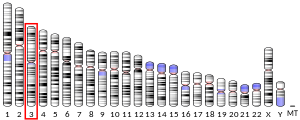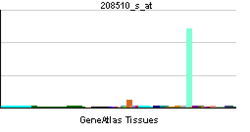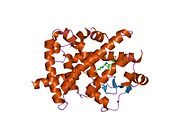페르옥시좀증식제활성화수용체 감마
Peroxisome proliferator-activated receptor gamma글리타존 리버스 인슐린 저항 수용체로 알려진 페르옥시좀 증식기 활성화 수용체 감마(PPAR-γ 또는 PPARG) 또는 NR1C3(핵수용체 서브패밀리 1, 그룹 C, 멤버 3)는 사람에게서 PPARG [5][6][7]유전자에 의해 암호화되는 전사 인자로 기능하는 II형 핵 수용체이다.
조직 분포
PPARG는 주로 지방조직, 대장 및 대식세포에 존재한다.PPARG의 두 가지 아이소폼은 사람과 마우스에서 검출된다. PPAR-δ1(근육을 제외한 거의 모든 조직에서 발견됨)과 PPAR-δ2(대부분 지방 조직과 [8][9]장에서 발견됨)이다.
유전자 발현
이 유전자는 핵수용체의 퍼옥시좀 증식자 활성화 수용체(PPAR) 서브패밀리의 멤버를 코드한다.PPAR은 레티노이드 X 수용체(RXR)와 함께 헤테로디머를 형성하고 이러한 헤테로디머는 다양한 유전자의 전사를 조절한다.PPAR에는 PPAR-alpha, PPAR-delta 및 PPAR-gamma의 3가지 서브타입이 알려져 있습니다.이 유전자에 의해 암호화된 단백질은 PPAR-감마이며 지방세포 분화의 조절제이다.다른 Isoform을 인코딩하는 대체 스플라이스된 전사 변형이 [10]설명되었습니다.
활성 PPARG는 MEK/ERK 경로를 통한 인산화를 통해 조절될 수 있다.이 변형은 PPARG의 전사 활성을 감소시키고 당뇨병 유전자 변형으로 이어지며 인슐린 불감증을 일으킨다.예를 들어 세린 112의 인산화 작용은 PPARG 기능을 억제하고 섬유아세포의 [11]지방 발생 가능성을 높인다.
기능.
PPARG는 지방산 저장과 포도당 대사를 조절한다.PPARG에 의해 활성화된 유전자는 지방세포에 의한 지질흡수와 지방형성을 자극한다.PPARG 녹아웃 마우스는 지방 조직이 결여되어 있어 PPARG가 지방세포 [12]분화의 주요 조절제로서 확립되어 있다.
PPARG는 지방세포의 지방산 저장량(지방독성 저감), 지방세포로부터의 아디포넥틴 방출량 증강, FGF21 유도,[12] CD38 [13]효소의 상향조절에 의한 니코틴산 아데닌디뉴클레오티드인산 생산을 증강함으로써 인슐린 감수성을 증가시킨다.
PPARG는 [14]생쥐에서 항염증성 M2 대식세포 활성화를 촉진한다.
아디포넥틴은 PPAR-γ 및 LXRα/[15]β의 활성화에 의해 ABCA1 매개 역콜레스테롤 수송을 유도한다.
많은 자연 발생 약물은 PPAR 감마선에 직접 결합하고 활성화한다.조직원들과5-oxo-eicosatetraenoic5-hydroxyicosatetraenoicacid 산성 가족의 일부 인사들이 같은 아라키돈산과 아라키돈산 대사 물질, 공압, 15(R)-HETE, 15ᆭ-HpETE,[16][17]는 경우에는 115(S)-HETE을 포함한 다양한polyunsaturated 지방산. 또는15-hydroxyicosatetraenoic5-oxo-ETE 5-oxo-15(S)-HETE 산성 가족들을 포함합니다.8]그 phyt오카나비노이드 테트라히드로카나비놀(THC),[19] 대사물 THC-COOH 및 합성 아날로그 아줄레미산(AJA)[20]이다.이러한 리간드와 다른 배위자에 의한 PPAR 감마 활성화는 배양된 인간 유방, 위, 폐, 전립선 [21][22]및 기타 암 세포주의 성장을 억제하는 역할을 할 수 있다.
태생 중에 PPARG는 먼저 경면간 갈색 지방 [23]패드에서 실질적으로 발현된다.PPARG의 고갈은 태반 혈관 이상으로 인해 E10.5에서 태아 혈관이 침투하지 않고 산모 혈액 [24]부비강이 확장 및 파열되는 배아 치사율을 초래할 것이다.PPARG 발현은 E8.5에 이르면 태반에서, 그리고 임신의 나머지 기간 동안, 주로 인간 [23]태반의 1차 영양아세포에 위치할 수 있다.적절한 태반 혈관 형성에 중요한 영양아세포 조직의 상피 분화에 PPARG가 필요하다.PPARG 작용제는 화려한 세포영양세포 침해를 억제한다.PPARG는 또한 [11]태반에 의한 지질 방울의 축적을 위해 필요하다.
상호 작용
페르옥시좀 증식기 활성화 수용체 감마선은 다음과 상호작용하는 것으로 나타났다.
임상 관련성
PPAR-gamma는 비만, 당뇨병, 아테롬성 동맥경화증,[35] 그리고 암을 포함한 많은 질병의 병리학에 관련되어 있다.PPAR-감마 작용제는 고지혈증과 고혈당 치료에 [36][37]사용되어 왔다.PPAR-감마는 많은 심혈관 세포, 특히 내피 세포의 염증 반응을 감소시킨다.[38]PPAR-gamma는 PON1 유전자를 활성화하여 간에서 파라옥소나아제1의 합성과 방출을 증가시켜 아테롬성 [39]동맥경화를 감소시킨다.
식이섬유가 적은 식단은 대장 내 미생물군에 의한 낙산 및 프로피온산의 생성을 감소시켜 이들 짧은 사슬 지방산이 PPAR-gamma를 [40]활성화하는 한 염증을 유발하거나 다른 악영향을 미칠 수 있다.PPAR-gamma가 낮으면 지방을 저장하는 지방조직의 용량이 감소하여 비지방조직(지방독성)[41]의 지방 저장량이 증가한다.콩단백질식은 지방조직 PPAR-gamma를 증가시켜 지방독성을 [41]저감한다.
당뇨병 치료에 사용되는 많은 인슐린 감수성 약물(즉 티아졸리디온)은 췌장 인슐린 분비를 증가시키지 않고 혈청 포도당을 낮추는 수단으로 PPARG를 활성화한다.PPARG의 활성화는 [42]간 인슐린 저항성보다 골격근 인슐린 저항성에 더 효과적이다.티아졸리딘디오니즈(일명 "PPARgamma의 부분작용제")보다 약한 PPARG를 활성화하는 여러 종류의 화합물이 현재 연구되고 있으며, 이러한 화합물은 여전히 저혈당제이지만 [43]부작용은 적을 것이라는 기대 속에 있다.
중쇄 트리글리세리드 데칸산은 지방 형성을 [44]증가시키지 않는 부분 활성 PPAR-감마 리간드인 것으로 나타났다.데칸산에 의한 PPAR-감마의 활성화는 미토콘드리아 수를 증가시키고, 미토콘드리아 효소 구연산합성효소를 증가시키며, 미토콘드리아에서 복합 I 활성을 증가시키며, 항산화 효소 카탈라아제의 [45]활성을 증가시키는 것으로 나타났다.
PPAR-δ1의 융합단백질과 갑상선전사인자 PAX8은 모낭갑상선암의 약 1/3에 존재하며, 구체적으로는 양쪽 [46][47]유전자의 일부를 병치할 수 있는 염색체 전이위 t(2;3)(q13;p25)의 암을 특이하게 한다.
피토카나비노이드 칸나비디올(CBD)은 시험관내 [48][49]및 생체내 모델에서 PPAR 감마를 활성화하는 것으로 나타났다.칸나비노이드 카르본산 THCA, CBDA 및 CBGA는 탈탄산화물보다 더 효율적으로 PPARy를 활성화하였으나, THCA는 가장 높은 활성을 가진 산이었다.아줄레미산은 THCcoCOOH(THC의 주요 비정신성 대사물)의 합성유사체로서도 강력한 PPARγ작용제이다.카르본산기는 더 강하고 긴 활성화 시간에 [50]매우 중요합니다.
「 」를 참조해 주세요.
레퍼런스
- ^ a b c GRCh38: 앙상블 릴리즈 89: ENSG00000132170 - 앙상블, 2017년 5월
- ^ a b c GRCm38: 앙상블 릴리즈 89: ENSMUSG000000440 - 앙상블, 2017년 5월
- ^ "Human PubMed Reference:". National Center for Biotechnology Information, U.S. National Library of Medicine.
- ^ "Mouse PubMed Reference:". National Center for Biotechnology Information, U.S. National Library of Medicine.
- ^ Greene ME, Blumberg B, McBride OW, Yi HF, Kronquist K, Kwan K, et al. (1995). "Isolation of the human peroxisome proliferator activated receptor gamma cDNA: expression in hematopoietic cells and chromosomal mapping". Gene Expression. 4 (4–5): 281–99. PMC 6134382. PMID 7787419.
- ^ Elbrecht A, Chen Y, Cullinan CA, Hayes N, Leibowitz MD, Moller DE, Berger J (July 1996). "Molecular cloning, expression and characterization of human peroxisome proliferator activated receptors gamma 1 and gamma 2". Biochemical and Biophysical Research Communications. 224 (2): 431–7. doi:10.1006/bbrc.1996.1044. PMID 8702406.
- ^ Michalik L, Auwerx J, Berger JP, Chatterjee VK, Glass CK, Gonzalez FJ, et al. (December 2006). "International Union of Pharmacology. LXI. Peroxisome proliferator-activated receptors". Pharmacological Reviews. 58 (4): 726–41. doi:10.1124/pr.58.4.5. PMID 17132851. S2CID 2240461.
- ^ Fajas L, Auboeuf D, Raspé E, Schoonjans K, Lefebvre AM, Saladin R, et al. (July 1997). "The organization, promoter analysis, and expression of the human PPARgamma gene". The Journal of Biological Chemistry. 272 (30): 18779–89. doi:10.1074/jbc.272.30.18779. PMID 9228052.
- ^ Park YK, Wang L, Giampietro A, Lai B, Lee JE, Ge K (January 2017). "Distinct Roles of Transcription Factors KLF4, Krox20, and Peroxisome Proliferator-Activated Receptor γ in Adipogenesis". Molecular and Cellular Biology. 37 (2): 18779–89. doi:10.1128/MCB.00554-16. PMC 5214852. PMID 27777310.
- ^ "Entrez Gene: PPARG peroxisome proliferator-activated receptor gamma".
- ^ a b Suwaki N, Masuyama H, Masumoto A, Takamoto N, Hiramatsu Y (April 2007). "Expression and potential role of peroxisome proliferator-activated receptor gamma in the placenta of diabetic pregnancy". Placenta. 28 (4): 315–23. doi:10.1016/j.placenta.2006.04.002. PMID 16753211.
- ^ a b Ahmadian M, Suh JM, Hah N, Liddle C, Atkins AR, Downes M, Evans RM (May 2013). "PPARγ signaling and metabolism: the good, the bad and the future". Nature Medicine. 19 (5): 557–66. doi:10.1038/nm.3159. PMC 3870016. PMID 23652116.
- ^ Song EK, Lee YR, Kim YR, Yeom JH, Yoo CH, Kim HK, et al. (December 2012). "NAADP mediates insulin-stimulated glucose uptake and insulin sensitization by PPARγ in adipocytes". Cell Reports. 2 (6): 1607–19. doi:10.1016/j.celrep.2012.10.018. PMID 23177620.
- ^ a b Peluso I, Morabito G, Urban L, Ioannone F, Serafini M (December 2012). "Oxidative stress in atherosclerosis development: the central role of LDL and oxidative burst". Endocrine, Metabolic & Immune Disorders Drug Targets. 12 (4): 351–60. doi:10.2174/187153012803832602. PMID 23061409.
- ^ Hafiane A, Gasbarrino K, Daskalopoulou SS (November 2019). "The role of adiponectin in cholesterol efflux and HDL biogenesis and metabolism". Metabolism. 100: 153953. doi:10.1016/j.metabol.2019.153953. PMID 31377319. S2CID 203413137.
- ^ Dreyer C, Keller H, Mahfoudi A, Laudet V, Krey G, Wahli W (1993). "Positive regulation of the peroxisomal beta-oxidation pathway by fatty acids through activation of peroxisome proliferator-activated receptors (PPAR)". Biology of the Cell. 77 (1): 67–76. doi:10.1016/s0248-4900(05)80176-5. PMID 8390886. S2CID 10746292.
- ^ O'Flaherty JT, Rogers LC, Paumi CM, Hantgan RR, Thomas LR, Clay CE, et al. (October 2005). "5-Oxo-ETE analogs and the proliferation of cancer cells". Biochimica et Biophysica Acta (BBA) - Molecular and Cell Biology of Lipids. 1736 (3): 228–36. doi:10.1016/j.bbalip.2005.08.009. PMID 16154383.
- ^ Naruhn S, Meissner W, Adhikary T, Kaddatz K, Klein T, Watzer B, et al. (February 2010). "15-hydroxyeicosatetraenoic acid is a preferential peroxisome proliferator-activated receptor beta/delta agonist". Molecular Pharmacology. 77 (2): 171–84. doi:10.1124/mol.109.060541. PMID 19903832. S2CID 30996954.
- ^ O'Sullivan SE, Tarling EJ, Bennett AJ, Kendall DA, Randall MD (November 2005). "Novel time-dependent vascular actions of Delta9-tetrahydrocannabinol mediated by peroxisome proliferator-activated receptor gamma". Biochemical and Biophysical Research Communications. 337 (3): 824–31. doi:10.1016/j.bbrc.2005.09.121. PMID 16213464.
- ^ Liu J, Li H, Burstein SH, Zurier RB, Chen JD (May 2003). "Activation and binding of peroxisome proliferator-activated receptor gamma by synthetic cannabinoid ajulemic acid". Molecular Pharmacology. 63 (5): 983–92. doi:10.1124/mol.63.5.983. PMID 12695526.
- ^ Krishnan A, Nair SA, Pillai MR (September 2007). "Biology of PPAR gamma in cancer: a critical review on existing lacunae". Current Molecular Medicine. 7 (6): 532–40. doi:10.2174/156652407781695765. PMID 17896990.
- ^ Ezzeddini R, Taghikhani M, Salek Farrokhi A, Somi MH, Samadi N, Esfahani A, Rasaee, MJ (May 2021). "Downregulation of fatty acid oxidation by involvement of HIF-1α and PPARγ in human gastric adenocarcinoma and its related clinical significance". Journal of Physiology and Biochemistry. 77 (2): 249–260. doi:10.1007/s13105-021-00791-3. PMID 33730333. S2CID 232300877.
- ^ a b Barak Y, Nelson MC, Ong ES, Jones YZ, Ruiz-Lozano P, Chien KR, et al. (October 1999). "PPAR gamma is required for placental, cardiac, and adipose tissue development". Molecular Cell. 4 (4): 585–95. doi:10.1016/s1097-2765(00)80209-9. PMID 10549290.
- ^ Schaiff WT, Barak Y, Sadovsky Y (April 2006). "The pleiotropic function of PPAR gamma in the placenta". Molecular and Cellular Endocrinology. 249 (1–2): 10–5. doi:10.1016/j.mce.2006.02.009. PMID 16574314. S2CID 54322301.
- ^ Brendel C, Gelman L, Auwerx J (June 2002). "Multiprotein bridging factor-1 (MBF-1) is a cofactor for nuclear receptors that regulate lipid metabolism". Molecular Endocrinology. 16 (6): 1367–77. doi:10.1210/mend.16.6.0843. PMID 12040021.
- ^ Berger J, Patel HV, Woods J, Hayes NS, Parent SA, Clemas J, et al. (April 2000). "A PPARgamma mutant serves as a dominant negative inhibitor of PPAR signaling and is localized in the nucleus". Molecular and Cellular Endocrinology. 162 (1–2): 57–67. doi:10.1016/S0303-7207(00)00211-2. PMID 10854698. S2CID 20343538.
- ^ Gampe RT, Montana VG, Lambert MH, Miller AB, Bledsoe RK, Milburn MV, et al. (March 2000). "Asymmetry in the PPARgamma/RXRalpha crystal structure reveals the molecular basis of heterodimerization among nuclear receptors". Molecular Cell. 5 (3): 545–55. doi:10.1016/S1097-2765(00)80448-7. PMID 10882139.
- ^ a b c Fajas L, Egler V, Reiter R, Hansen J, Kristiansen K, Debril MB, et al. (December 2002). "The retinoblastoma-histone deacetylase 3 complex inhibits PPARgamma and adipocyte differentiation". Developmental Cell. 3 (6): 903–10. doi:10.1016/S1534-5807(02)00360-X. PMID 12479814.
- ^ a b c d Kodera Y, Takeyama K, Murayama A, Suzawa M, Masuhiro Y, Kato S (October 2000). "Ligand type-specific interactions of peroxisome proliferator-activated receptor gamma with transcriptional coactivators". The Journal of Biological Chemistry. 275 (43): 33201–4. doi:10.1074/jbc.C000517200. PMID 10944516.
- ^ Franco PJ, Li G, Wei LN (August 2003). "Interaction of nuclear receptor zinc finger DNA binding domains with histone deacetylase". Molecular and Cellular Endocrinology. 206 (1–2): 1–12. doi:10.1016/S0303-7207(03)00254-5. PMID 12943985. S2CID 19487189.
- ^ Heinlein CA, Ting HJ, Yeh S, Chang C (June 1999). "Identification of ARA70 as a ligand-enhanced coactivator for the peroxisome proliferator-activated receptor gamma". The Journal of Biological Chemistry. 274 (23): 16147–52. doi:10.1074/jbc.274.23.16147. PMID 10347167.
- ^ Nishizawa H, Yamagata K, Shimomura I, Takahashi M, Kuriyama H, Kishida K, et al. (January 2002). "Small heterodimer partner, an orphan nuclear receptor, augments peroxisome proliferator-activated receptor gamma transactivation". The Journal of Biological Chemistry. 277 (2): 1586–92. doi:10.1074/jbc.M104301200. PMID 11696534.
- ^ Wallberg AE, Yamamura S, Malik S, Spiegelman BM, Roeder RG (November 2003). "Coordination of p300-mediated chromatin remodeling and TRAP/mediator function through coactivator PGC-1alpha". Molecular Cell. 12 (5): 1137–49. doi:10.1016/S1097-2765(03)00391-5. PMID 14636573.
- ^ Puigserver P, Adelmant G, Wu Z, Fan M, Xu J, O'Malley B, Spiegelman BM (November 1999). "Activation of PPARgamma coactivator-1 through transcription factor docking". Science. 286 (5443): 1368–71. doi:10.1126/science.286.5443.1368. PMID 10558993.
- ^ Ezzeddini R, Taghikhani M, Salek Farrokhi A, Somi MH, Samadi N, Esfahani A, Rasaee, MJ (May 2021). "Downregulation of fatty acid oxidation by involvement of HIF-1α and PPARγ in human gastric adenocarcinoma and its related clinical significance". Journal of Physiology and Biochemistry. 77 (2): 249–260. doi:10.1007/s13105-021-00791-3. PMID 33730333. S2CID 232300877.
- ^ Lehrke M, Lazar MA (December 2005). "The many faces of PPARgamma". review. Cell. 123 (6): 993–9. doi:10.1016/j.cell.2005.11.026. PMID 16360030. S2CID 18526710.
- ^ Kim JH, Song J, Park KW (March 2015). "The multifaceted factor peroxisome proliferator-activated receptor γ (PPARγ) in metabolism, immunity, and cancer". review. Archives of Pharmacal Research. 38 (3): 302–12. doi:10.1007/s12272-015-0559-x. PMID 25579849. S2CID 12296573.
- ^ Hamblin M, Chang L, Fan Y, Zhang J, Chen YE (June 2009). "PPARs and the cardiovascular system". review. Antioxidants & Redox Signaling. 11 (6): 1415–52. doi:10.1089/ARS.2008.2280. PMC 2737093. PMID 19061437.
- ^ Khateeb J, Gantman A, Kreitenberg AJ, Aviram M, Fuhrman B (January 2010). "Paraoxonase 1 (PON1) expression in hepatocytes is upregulated by pomegranate polyphenols: a role for PPAR-gamma pathway". primary. Atherosclerosis. 208 (1): 119–25. doi:10.1016/j.atherosclerosis.2009.08.051. PMID 19783251.
- ^ Kumar J, Rani K, Datt C (2020). "Molecular link between dietary fibre, gut microbiota and health". Molecular Biology Reports. 47 (8): 6229–6237. doi:10.1007/s11033-020-05611-3. PMID 32623619. S2CID 220337072.
- ^ a b Tovar AR, Torres N (March 2010). "The role of dietary protein on lipotoxicity". Biochimica et Biophysica Acta (BBA) - Molecular and Cell Biology of Lipids. 1801 (3): 367–71. doi:10.1016/j.bbalip.2009.09.007. PMID 19800415.
- ^ Abdul-Ghani MA, Tripathy D, DeFronzo RA (May 2006). "Contributions of beta-cell dysfunction and insulin resistance to the pathogenesis of impaired glucose tolerance and impaired fasting glucose". review. Diabetes Care. 29 (5): 1130–9. doi:10.2337/dc05-2179. PMID 16644654.
- ^ Chigurupati S, Dhanaraj SA, Balakumar P (May 2015). "A step ahead of PPARγ full agonists to PPARγ partial agonists: therapeutic perspectives in the management of diabetic insulin resistance". review. European Journal of Pharmacology. 755: 50–7. doi:10.1016/j.ejphar.2015.02.043. PMID 25748601.
- ^ Malapaka RR, Khoo S, Zhang J, Choi JH, Zhou XE, Xu Y, et al. (January 2012). "Identification and mechanism of 10-carbon fatty acid as modulating ligand of peroxisome proliferator-activated receptors". primary. The Journal of Biological Chemistry. 287 (1): 183–95. doi:10.1074/jbc.M111.294785. PMC 3249069. PMID 22039047.
- ^ Hughes SD, Kanabus M, Anderson G, Hargreaves IP, Rutherford T, O'Donnell M, et al. (May 2014). "The ketogenic diet component decanoic acid increases mitochondrial citrate synthase and complex I activity in neuronal cells". primary. Journal of Neurochemistry. 129 (3): 426–33. doi:10.1111/jnc.12646. PMID 24383952. S2CID 206089968.
- ^ Kroll TG, Sarraf P, Pecciarini L, Chen CJ, Mueller E, Spiegelman BM, Fletcher JA (August 2000). "PAX8-PPARgamma1 fusion oncogene in human thyroid carcinoma [corrected]". primary. Science. 289 (5483): 1357–60. Bibcode:2000Sci...289.1357K. doi:10.1126/science.289.5483.1357. PMID 10958784.
- ^ Mitchell RS, Kumar V, Abbas AK, Fausto N, eds. (2007). "Chapter 20: The Endocrine System". Robbins Basic Pathology. review (8th ed.). Philadelphia: Saunders/Elsevier. ISBN 978-1-4160-2973-1.
- ^ Ramer R, Heinemann K, Merkord J, Rohde H, Salamon A, Linnebacher M, Hinz B (January 2013). "COX-2 and PPAR-γ confer cannabidiol-induced apoptosis of human lung cancer cells". Molecular Cancer Therapeutics. 12 (1): 69–82. doi:10.1158/1535-7163.MCT-12-0335. PMID 23220503.
- ^ De Filippis D, Esposito G, Cirillo C, Cipriano M, De Winter BY, Scuderi C, et al. (December 2011). "Cannabidiol reduces intestinal inflammation through the control of neuroimmune axis". PLOS ONE. 6 (12): e28159. Bibcode:2011PLoSO...628159D. doi:10.1371/journal.pone.0028159. PMC 3232190. PMID 22163000.
- ^ Nadal X, Del Río C, Casano S, Palomares B, Ferreiro-Vera C, Navarrete C, et al. (December 2017). "Tetrahydrocannabinolic acid is a potent PPARγ agonist with neuroprotective activity". British Journal of Pharmacology. 174 (23): 4263–4276. doi:10.1111/bph.14019. PMC 5731255. PMID 28853159.
추가 정보
- Qi C, Zhu Y, Reddy JK (2001). "Peroxisome proliferator-activated receptors, coactivators, and downstream targets". Cell Biochemistry and Biophysics. 32 Spring (1–3): 187–204. doi:10.1385/cbb:32:1-3:187. PMID 11330046. S2CID 31795393.
- Kadowaki T, Hara K, Kubota N, Tobe K, Terauchi Y, Yamauchi T, et al. (2002). "The role of PPARgamma in high-fat diet-induced obesity and insulin resistance". Journal of Diabetes and Its Complications. 16 (1): 41–5. doi:10.1016/S1056-8727(01)00206-9. PMID 11872365.
- Wakino S, Law RE, Hsueh WA (2002). "Vascular protective effects by activation of nuclear receptor PPARgamma". Journal of Diabetes and Its Complications. 16 (1): 46–9. doi:10.1016/S1056-8727(01)00197-0. PMID 11872366.
- Takano H, Komuro I (2002). "Roles of peroxisome proliferator-activated receptor gamma in cardiovascular disease". Journal of Diabetes and Its Complications. 16 (1): 108–14. doi:10.1016/S1056-8727(01)00203-3. PMID 11872377.
- Stumvoll M, Häring H (August 2002). "The peroxisome proliferator-activated receptor-gamma2 Pro12Ala polymorphism". Diabetes. 51 (8): 2341–7. doi:10.2337/diabetes.51.8.2341. PMID 12145143.
- Koeffler HP (January 2003). "Peroxisome proliferator-activated receptor gamma and cancers". Clinical Cancer Research. 9 (1): 1–9. PMID 12538445.
- Puigserver P, Spiegelman BM (February 2003). "Peroxisome proliferator-activated receptor-gamma coactivator 1 alpha (PGC-1 alpha): transcriptional coactivator and metabolic regulator". Endocrine Reviews. 24 (1): 78–90. doi:10.1210/er.2002-0012. PMID 12588810.
- Takano H, Hasegawa H, Nagai T, Komuro I (May 2003). "The role of PPARgamma-dependent pathway in the development of cardiac hypertrophy". Drugs of Today. 39 (5): 347–57. doi:10.1358/dot.2003.39.5.799458. PMID 12861348.
- Rangwala SM, Lazar MA (June 2004). "Peroxisome proliferator-activated receptor gamma in diabetes and metabolism". Trends in Pharmacological Sciences. 25 (6): 331–6. doi:10.1016/j.tips.2004.03.012. PMID 15165749.
- Cuzzocrea S (July 2004). "Peroxisome proliferator-activated receptors gamma ligands and ischemia and reperfusion injury". Vascular Pharmacology. 41 (6): 187–95. doi:10.1016/j.vph.2004.10.004. PMID 15653094.
- Savage DB (January 2005). "PPAR gamma as a metabolic regulator: insights from genomics and pharmacology". Expert Reviews in Molecular Medicine. 7 (1): 1–16. doi:10.1017/S1462399405008793. PMID 15673477.
- Pégorier JP (April 2005). "[PPAR receptors and insulin sensitivity: new agonists in development]". Annales d'Endocrinologie. 66 (2 Pt 2): 1S10–7. PMID 15959400.
- Tsai YS, Maeda N (April 2005). "PPARgamma: a critical determinant of body fat distribution in humans and mice". Trends in Cardiovascular Medicine. 15 (3): 81–5. doi:10.1016/j.tcm.2005.04.002. PMID 16039966.
- Gurnell M (December 2005). "Peroxisome proliferator-activated receptor gamma and the regulation of adipocyte function: lessons from human genetic studies". Best Practice & Research. Clinical Endocrinology & Metabolism. 19 (4): 501–23. doi:10.1016/j.beem.2005.10.001. PMID 16311214.
- Cecil JE, Watt P, Palmer CN, Hetherington M (June 2006). "Energy balance and food intake: the role of PPARgamma gene polymorphisms". Physiology & Behavior. 88 (3): 227–33. doi:10.1016/j.physbeh.2006.05.028. PMID 16777151. S2CID 54243343.
- Rousseaux C, Desreumaux P (2007). "[The peroxisome-proliferator-activated gamma receptor and chronic inflammatory bowel disease (PPARgamma and IBD)]". Journal de la Société de Biologie. 200 (2): 121–31. doi:10.1051/jbio:2006015. PMID 17151549.
- Eriksson JG (April 2007). "Gene polymorphisms, size at birth, and the development of hypertension and type 2 diabetes". The Journal of Nutrition. 137 (4): 1063–5. doi:10.1093/jn/137.4.1063. PMID 17374678.
- Tönjes A, Stumvoll M (July 2007). "The role of the Pro12Ala polymorphism in peroxisome proliferator-activated receptor gamma in diabetes risk". Current Opinion in Clinical Nutrition and Metabolic Care. 10 (4): 410–4. doi:10.1097/MCO.0b013e3281e389d9. PMID 17563457. S2CID 30323803.
- Burgermeister E, Seger R (July 2007). "MAPK kinases as nucleo-cytoplasmic shuttles for PPARgamma". Cell Cycle. 6 (13): 1539–48. doi:10.4161/cc.6.13.4453. PMID 17611413.
- Papageorgiou E, Pitulis N, Msaouel P, Lembessis P, Koutsilieris M (August 2007). "The non-genomic crosstalk between PPAR-gamma ligands and ERK1/2 in cancer cell lines". Expert Opinion on Therapeutic Targets. 11 (8): 1071–85. doi:10.1517/14728222.11.8.1071. PMID 17665979. S2CID 86480850.

































